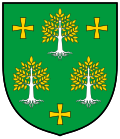Top Qs
Timeline
Chat
Perspective
Coat of arms of Budapest
From Wikipedia, the free encyclopedia
Remove ads
The coat of arms of Budapest[3] (capital city of Hungary) has existed since 1873, when the three main cities next to the Danube river (Buda, Pest and Óbuda) were united in one after existing during a millennium separately. The city committee that was planning the city's unification asked the master-painter Lajos Friedrich to design the coat of arms based on the cities' previous symbols and coats.
This article needs additional citations for verification. (July 2014) |
Remove ads
Description of the coat of arms
The coat of arms is composed of two blasons: the superior contains a castle with one tower that represents Pest, as well the inferior a three-towered castle that actually symbolizes Buda (where the Royal Palace of Buda is located).[citation needed] The undulated white stripe in the middle of both blasons represents the Danube river which separates Buda and Pest (passing through the middle of the city). On the top of the coat of arms lies the Crown of the King Saint Stephen. A two-legged standing lion grabs the city symbol with its protector claws on the left side, with a mythological griffin on the right.
Remove ads
History
After Hungary was invaded by the Soviet armies, soon the coat of arms lost the Holy Crown on it, and was used from 1946 to 1949 without it.[citation needed] Between 1964 and 1990, a new coat of arms was used, avoiding to use the traditional Hungarian symbols that did not match with the communist ideals. After the fall of the Soviet Union, Hungary recovered its independence and in 1990 the original coat of arms created in 1873 was again reestablished.[citation needed]
Remove ads
Gallery
Coats of arms of districts
References
Bibliography
Wikiwand - on
Seamless Wikipedia browsing. On steroids.
Remove ads
































